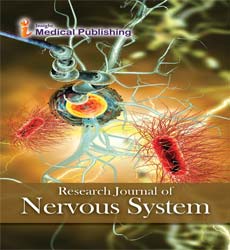The Parasympathetic Device is Answerable for Stimulation of Autonomic Apprehensive Device
Boulenouar Mesraoua *
Neurosciences Department, Hamad Medical Corporation and Weill Cornell Medical College, Doha, Qatar
*Corresponding author: Boulenouar Mesraoua, Neurosciences Department, Hamad Medical Corporation and Weill Cornell Medical College, Doha,
Qatar; E-mail: boulenouar.mesraoua@wanadoo.fr
Received date: November 02, 2021; Accepted date: November 16, 2021; Published date: November 23, 2021
Citation: Mesraoua B (2021) The Parasympathetic Device is Answerable for Stimulation of Autonomic Apprehensive Device. J Nerv Syst Vol.5 No.5: 013
Description
The autonomic apprehensive device is responsible for regulating the frame's subconscious actions. The parasympathetic device is answerable for stimulation of "rest-and-digest" or "feed and breed activities that arise while the frame is at rest, especially after eating, such as sexual arousal, salivation, lacrimation (tears), urination, digestion, and defecation. Its motion is defined as being complementary to that of the sympathetic worried device, which is liable for stimulating sports related to the fight-orflight response. Nerve fibers of the parasympathetic apprehensive system rise up from the significant nervous machine. Specific nerves include several cranial nerves, in particular the coulometer nerve, facial nerve, glossopharyngeal nerve, and vague nerve. The pelvic splanchnic efferent preganglionic nerve cell bodies are living within the lateral grey horn of the spinal cord at the and their axons exit the vertebral column spinal nerves via the sacral foramina. The parasympathetic ganglion where these preganglionic neurons synapse could be near the innervation.
Axons of Presynaptic Parasympathetic Neurons
This differs from the sympathetic frightened gadget, where synapses between pre- and post-ganglionic efferent nerves in popular arise at ganglia which might be farther away from the target organ As inside the sympathetic fearful system, efferent parasympathetic nerve indicators are carried from the critical nervous device to their targets through a system of two neurons. The primary neuron on this pathway is referred to as the preganglionic or presynaptic neuron. Its cellular frame sits within the significant worried machine and its axon usually extends to synapse with the dendrites of a postganglionic neuron someplace else inside the body.
The axons of presynaptic parasympathetic neurons are normally long, extending from the right into a ganglion that is both very close to or embedded of their target organ. As a result, the postsynaptic parasympathetic nerve fibers are very short separate organization of parasympathetic leaving from the pterygopalatine ganglion are the descending palatine nerves, which include the greater and lesser palatine nerves. The greater palatine parasympathetic synapses on the difficult palate and alter mucus glands placed there. The lesser palatine nerve synapses on the gentle palate and controls sparse taste receptors and mucus glands. but some other set of divisions from the pterygopalatine ganglion are the posterior, advanced, and inferior lateral nasal nerves; and the nasopalatine nerves that carry parasympathetic innervation to glands of the nasal mucosa. The second one parasympathetic department that leaves the facial nerve is the chorda tympani.
Nerve Contains Secret Motor Fibers
This nerve contains secret motor fibers to the submandibular and sublingual glands. The chorda tympani travel through the center ear and attaches to the lingual. After joining the lingual nerve, the preganglionic fibers synapse on the submandibular ganglion and ship postganglionic fibers to the sublingual and submandibular salivary glands. The glossopharyngeal nerve has parasympathetic fibers that innervate the parotid salivary gland. The preganglionic fibers go away as the tympanic nerve and continue to the middle ear wherein they make up a tympanic plexus at the cochlear promontory of the mesotympanum. The tympanic plexus of nerves rejoin and form the lesser perusal nerve and exit thru the foramen oval to synapse on the optic ganglion. From the optic ganglion postganglionic parasympathetic fibers tour with the auriculotemporal nerve mandibular branch of trigeminal, to the parotid salivary gland the coulometer nerve is accountable for a number of parasympathetic capabilities related to the attention. The first is the extra perusal nerve and the second one is the chorda tympani.
Open Access Journals
- Aquaculture & Veterinary Science
- Chemistry & Chemical Sciences
- Clinical Sciences
- Engineering
- General Science
- Genetics & Molecular Biology
- Health Care & Nursing
- Immunology & Microbiology
- Materials Science
- Mathematics & Physics
- Medical Sciences
- Neurology & Psychiatry
- Oncology & Cancer Science
- Pharmaceutical Sciences
